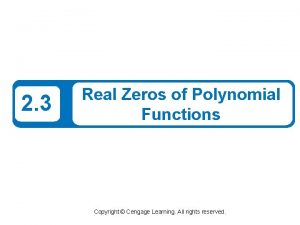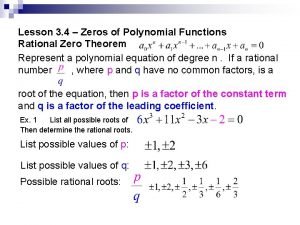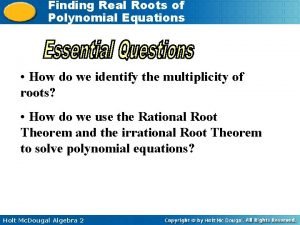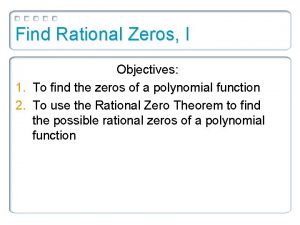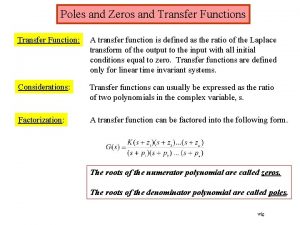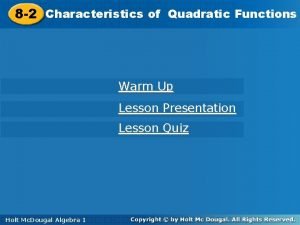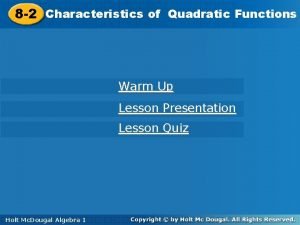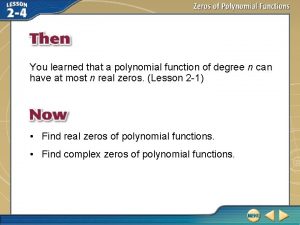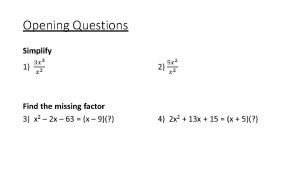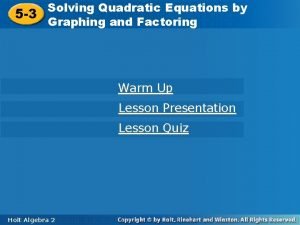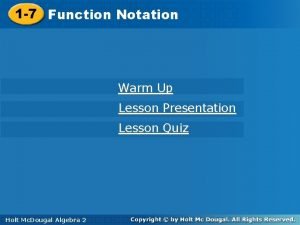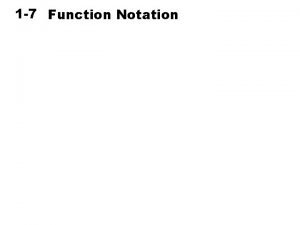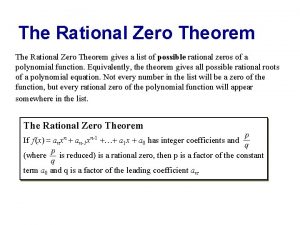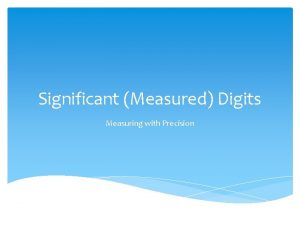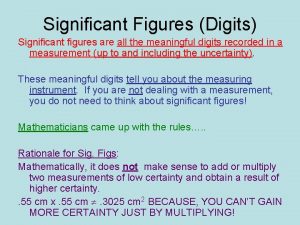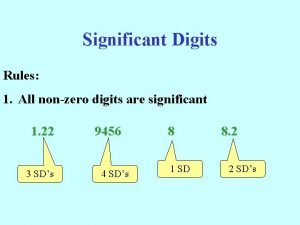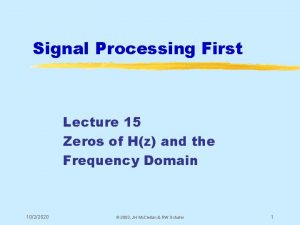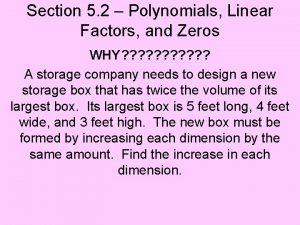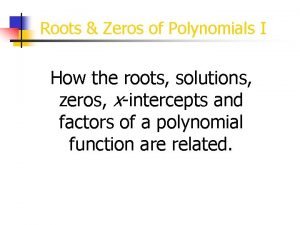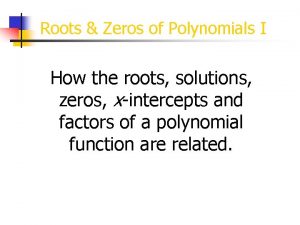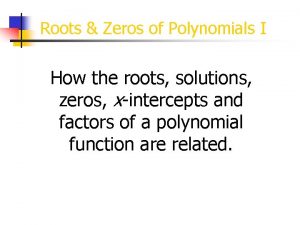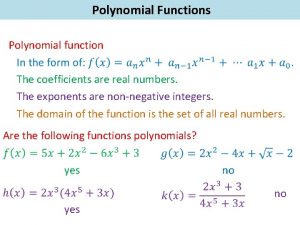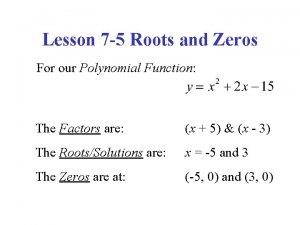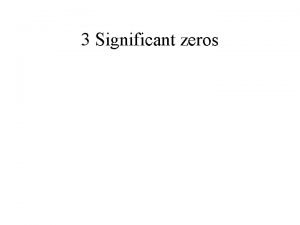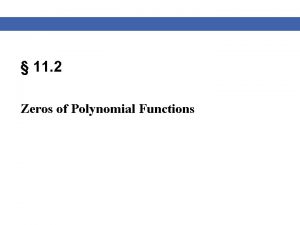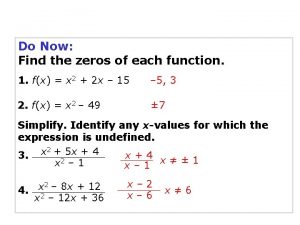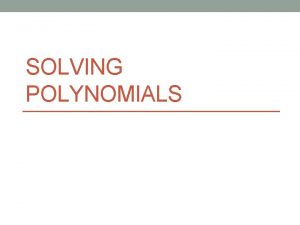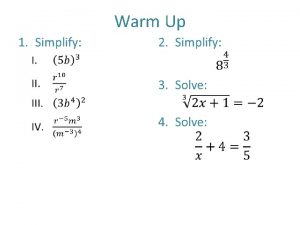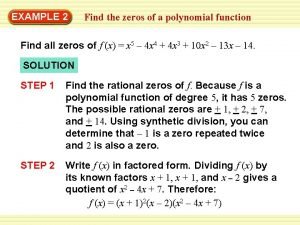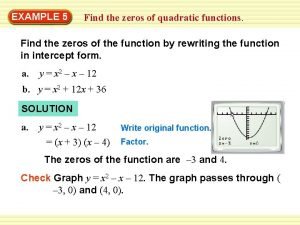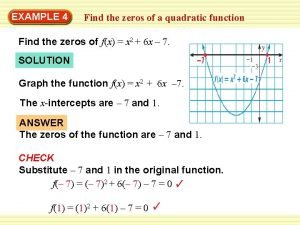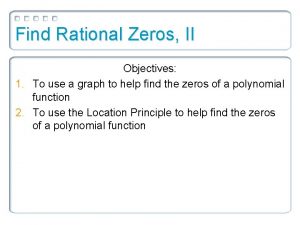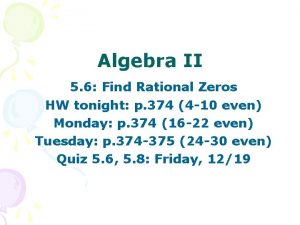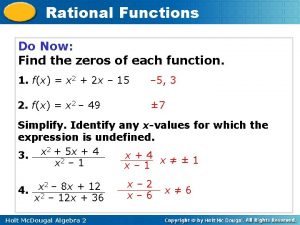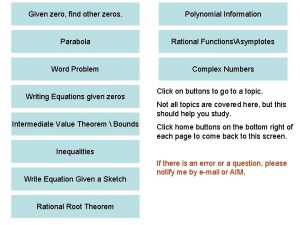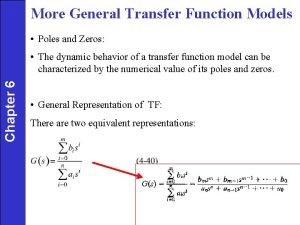warm up Find the zeros of the function










![Step function greatest integer function • Equation: y = [|x|] • Example: y = Step function greatest integer function • Equation: y = [|x|] • Example: y =](https://slidetodoc.com/presentation_image_h2/3c8d85fce0ae3f86421c330d8cfb94ff/image-11.jpg)

















- Slides: 28

warm up • Find the zeros of the function • f(x) = 9 x 4 – 25 x 2

Linear Functions • Equation: Y = mx + b • Example: y = 3 x – 2 • Key characteristics: largest exponent 1

Quadratic function • Equation: y = ax 2 + bx + c • Example: y = 2 x 2 + 3 x – 5 • Key characteristics: largest exponent 2

Cubic function • Equation: y = ax 3 + bx 2 + cx + d • Example: y = -3 x 3 + 2 x 2 + 3 x – 5 • Key characteristics: largest exponent 3

Absolute Value function • Equation: y = |x - h | + k • Example: y = | x + 3| - 4 • Key characteristics: absolute value bars

Square Root function •

Reciprocal/ Rational function •

Exponential function • Equation: y = ax • Example: y = 2 x • Key characteristics: variable as an exponent

logarithmic function • Equation: y = logb x • Example: y = log 2 x • Key characteristics: logarithm

piecewise function f(x) = x 2 + 1 , x 0 x– 1, x 0
![Step function greatest integer function Equation y x Example y Step function greatest integer function • Equation: y = [|x|] • Example: y =](https://slidetodoc.com/presentation_image_h2/3c8d85fce0ae3f86421c330d8cfb94ff/image-11.jpg)
Step function greatest integer function • Equation: y = [|x|] • Example: y = [|2 x + 1|] • Key characteristics: greatest integer function symbol

Name the parent function from the graphs below.

Describe the shape of the equations below • f(x) = √(x) + 3 • f(x) = 1/(x-3) • f(x) = Ix-2 I • f(x) = 2 x 3 -3 • f(x) = [[x]] + 3

Describe the shape and equation of the following functions • Linear function • Square root function • Exponential function • Cubic function • Piecewise function • Reciprocal function • Step function • Quadratic function • Logarithmic function • Absolute value function

homework • Page 71 • 1 – 9 (all) , 57, 59, 61 • Page 80 • 27 – 41 (odd) a – c

Exploring transformations • ________ - a change in the position, size or shape of a figure. • A _________, or slide is a transformation that moves each point in a figure the same distance in the same direction.

Vertical and Horizontal translations • Vertical translation up h(x) = f(x) + c • Vertical translation down h(x) = f(x) – c • Horizontal translation right h(x) = f(x - c) • Horizontal translation left h(x) = f(x + c)

Vertical and horizontal translations

Vertical and horizontal translations • Describe the translations taking place • F(x) = |x + 3| • F(x) = |x| - 4 • F(x) = (x – 4)2 • F(x) = (x + 2)2 – 3

Identify the translation(s) taking place in the following functions • f(x) = x 2 + 3 • f(x) = (x - 4)2 • h(x) = (x+2)3 +1 • g(x) = √(x-3) +5

reflection • A reflection is a transformation that flips across a line called the line of reflection. • Reflection over the x-axis h(x) = -f(x) • Reflection over the y-axis h(x) = f(-x)

Reflecting graphs • Reflection over the y-axis • F(x)=(x-2)2 - 1 • F(x)=(-x-2)2 - 1 �Reflection over the x-axis �F(x)= x 2 �F(x)= -x 2

Describe the transformations taking place • F(x) = -|x + 2| - 3 • F(x) = (-x + 2)2 + 3 • F(x) = - (x + 2) • F(x) = |-x + 2|

Nonrigid Transformations Nonrigid transformations are those that cause a distortion—a change in the shape of the original graph. Vertical Stretch or shrink h(x) = cf(x) vertical stretch c > 1 vertical shrink 0 < c < 1 Horizontal Stretch or Shrink h(x) = f(cx) horizontal shrink c > 1 horizontal stretch 0 < c < 1

Example 4 – Nonrigid Transformations Compare the graph of each function with the graph of f (x) = | x |. a. h(x) = 3| x | b. g(x) = |x|

Example 4 – Nonrigid Transformations Compare the graph of each function with the graph of f (x) = x 2 a. h(x) = | 2 x | b. g(x) = | x |

Describe the transformation on the following functions • k(x) = ½ x 2 • f(x) = (9/4 x)3 – 7 • h(x) = 2√(x + 3) • g(x) = -(2 x - 5)2 + 4

homework • page 65 • 1 - 9 ( all) • page 73 • 21 - 29 (odd) • 47 and 49
 Rational zeros vs real zeros
Rational zeros vs real zeros How to find the zeros of a function
How to find the zeros of a function Zero.product property
Zero.product property Solving polynomial equations
Solving polynomial equations How to find rational zeros
How to find rational zeros Possible rational zeros calculator
Possible rational zeros calculator Poles and zeros
Poles and zeros 8-2 quadratic functions
8-2 quadratic functions 8-2 lesson quiz quadratic functions in vertex form
8-2 lesson quiz quadratic functions in vertex form Which polynomial function has zeros -2,1/2,2,1?
Which polynomial function has zeros -2,1/2,2,1? The zeros of the function f(x)=x^3-9x^2 are
The zeros of the function f(x)=x^3-9x^2 are Polynomial roots matlab
Polynomial roots matlab 5-3 solving quadratic equations by factoring answer key
5-3 solving quadratic equations by factoring answer key Function notation warm up
Function notation warm up Function notation warm up
Function notation warm up Function notation table
Function notation table Listing all possible rational zeros
Listing all possible rational zeros Are zeros to the left of the decimal significant
Are zeros to the left of the decimal significant Rules of sig figs
Rules of sig figs Significant figures conversion
Significant figures conversion Rounding non zero digit calculator
Rounding non zero digit calculator 15 zeros
15 zeros 5-2 polynomials linear factors and zeros form g
5-2 polynomials linear factors and zeros form g Roots and zeros
Roots and zeros How do you find roots
How do you find roots How do you find roots
How do you find roots Polynomial function
Polynomial function 5-7 roots and zeros
5-7 roots and zeros How to count sig figs in scientific notation
How to count sig figs in scientific notation
